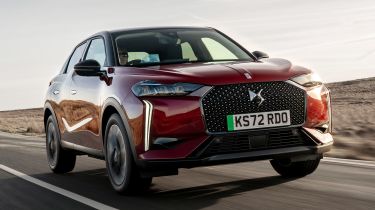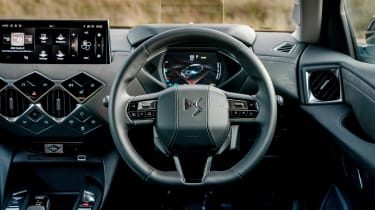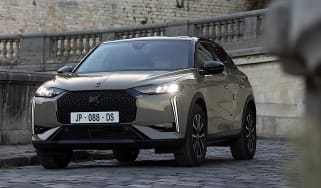DS 3 E-Tense review
The DS 3 E-Tense is a quirky and refined electric SUV, but longer range and new tech don’t put it to the front of the pack

Pros
- 250-mile range
- Refinement
- Build quality
Cons
- Touch-sensitive controls
- Limited interior space
- Expensive
| Car type | Official range | Wallbox charge time | Rapid charge time |
|---|---|---|---|
| Electric | 250 miles | 7hrs 30mins (0-100%, 7.4kW) | 30mins (10-80%, 100kW) |
DS 3 E-Tense verdict
The DS 3 E-Tense is essentially a posher Vauxhall Mokka Electric, offering that car’s relaxing driving experience and high driving position, but in a chicer, more Parisian package. We welcome the updates for 2023 – especially the longer range and more responsive touchscreen – but ultimately, we feel the DS 3 E-Tense struggles to live up to its high price tag – especially when larger and more compelling EVs cost around the same money.
Range details, specs and alternatives
Citroen’s premium offshoot DS is known for putting an upmarket spin on tried-and-tested components, and the electric DS 3 Crossback E-Tense (yes, that was its official name) did just that. Underneath the quirky styling and slightly unconventional cabin design was the same running gear used to power numerous EVs from Citroen, Vauxhall and Peugeot.
Well now, not only has the compact electric SUV dropped the ‘Crossback’ from its name, it's been given a facelift, a new infotainment system and some extra range courtesy of a bigger 51kWh (usable) battery and more powerful electric motor – the same setup as the new Jeep Avenger.
As a result, the updated DS 3 can manage up to 250 miles on a single charge, which is an increase from 193 miles on the old Crossback model. As before, 100kW rapid DC charging capability comes as standard, allowing for a 10-80% charge in around half an hour if connected to a fast enough public charger.
The DS 3’s electric motor now also produces 154bhp (an increase of 20bhp), which means 0-62mph stacks up a leisurely (for an electric car) nine seconds – although performance should be more than sufficient for driving around town.
Aside from the extra power and range, facelifted cars are marked out by a pair of vertical LED strakes each side of the grille, which itself has become wider with this update. Depending on the trim level, the grille is decorated with gloss black or chromed diamond tips, while inside every model now comes with a 10.3-inch central touchscreen that’s noticeably more responsive than the old unit. However, the touch sensitive dashboard layout is still fiddly and unintuitive to use.
There are four trim levels to choose from: Performance Line, Performance Line+, Rivoli and Opera. Entry-level Performance Line cars come in at over £37,000, which is more than you’d pay for a base Cupra Born or any of the DS 3’s mechanical siblings, like the Peugeot e-2008. Thankfully, there’s a decent amount of standard equipment, with even base cars getting LED headlights, 17-inch diamond-cut alloy wheels, climate control, Alcantara suede upholstery and rear parking sensors, plus the aforementioned infotainment touchscreen with Apple CarPlay and Android Auto connectivity.
Stepping up to Performance Line+ adds larger 18-inch wheels, rear privacy glass, keyless entry and built-in sat nav, while Rivoli trim benefits from chrome exterior detailing, a two-tone roof and leather upholstery. Finally, the top-spec Opera model starts from an eye-watering £42,700 – only slightly less than the far-superior Tesla Model Y – and gets all the bells and whistles that you’d expect like a head-up display, a wireless charging pad, Nappa leather upholstery and an expanded list of driver aids including blind-spot monitoring, front parking sensors and a reversing camera.
For more on the DS 3 E-Tense, read on for the rest of our in-depth review...


